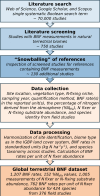A global dataset of terrestrial biological nitrogen fixation
- PMID: 40764484
- PMCID: PMC12325739
- DOI: 10.1038/s41597-025-05131-4
A global dataset of terrestrial biological nitrogen fixation
Abstract
Biological nitrogen fixation (BNF) is the main natural source of new nitrogen inputs in terrestrial ecosystems, supporting terrestrial productivity, carbon uptake, and other Earth system processes. We assembled a comprehensive global dataset of field measurements of BNF in all major N-fixing niches across natural terrestrial biomes derived from the analysis of 376 BNF studies. The dataset comprises 32 variables, including site location, biome type, N-fixing niche, sampling year, quantification method, BNF rate (kg N ha-1 y-1), the percentage of nitrogen derived from the atmosphere (%Ndfa), N fixer or N-fixing substrate abundance, BNF rate per unit of N fixer abundance, and species identity. Overall, the dataset combines 1,207 BNF rates for trees, shrubs, herbs, soil, leaf litter, woody litter, dead wood, mosses, lichens, and biocrusts, 152 herb %Ndfa values, 1,005 measurements of N fixer or N-fixing substrate abundance, and 762 BNF rates per unit of N fixer abundance for a total of 424 species across 66 countries. This dataset facilitates synthesis, meta-analysis, upscaling, and model benchmarking of BNF fluxes at multiple spatial scales.
© 2025. The Authors. Parts of this work were authored by US Federal Government authors and are not under copyright protection in the US; foreign copyright protection may apply.
Conflict of interest statement
Competing interests: The authors declare no competing interests.
Figures






References
-
- LeBauer, D. S. & Treseder, K. K. Nitrogen limitation of net primary productivity in terrestrial ecosystems is globally distributed. Ecology89, 371–379, 10.1890/06-2057.1 (2008). - PubMed
-
- Du, E. et al. Global patterns of terrestrial nitrogen and phosphorus limitation. Nat Geosci13, 221–226, 10.1038/s41561-019-0530-4 (2020).
-
- Craine, J. M., Morrow, C. & Fierer, N. Microbial nitrogen limitation increases decomposition. Ecology88, 2105–2113, 10.1890/06-1847.1 (2007). - PubMed
-
- Cleveland, C. C. et al. Exploring the Role of Cryptic Nitrogen Fixers in Terrestrial Ecosystems: A Frontier in Nitrogen Cycling Research. Ecosystems25, 1653–1669, 10.1007/s10021-022-00804-2 (2022).
-
- Soper, F. M. et al. A roadmap for sampling and scaling biological nitrogen fixation in terrestrial ecosystems. Methods Ecol Evol12, 1122–1137, 10.1111/2041-210X.13586 (2021).
Publication types
MeSH terms
Substances
Grants and funding
LinkOut - more resources
Full Text Sources
Research Materials

